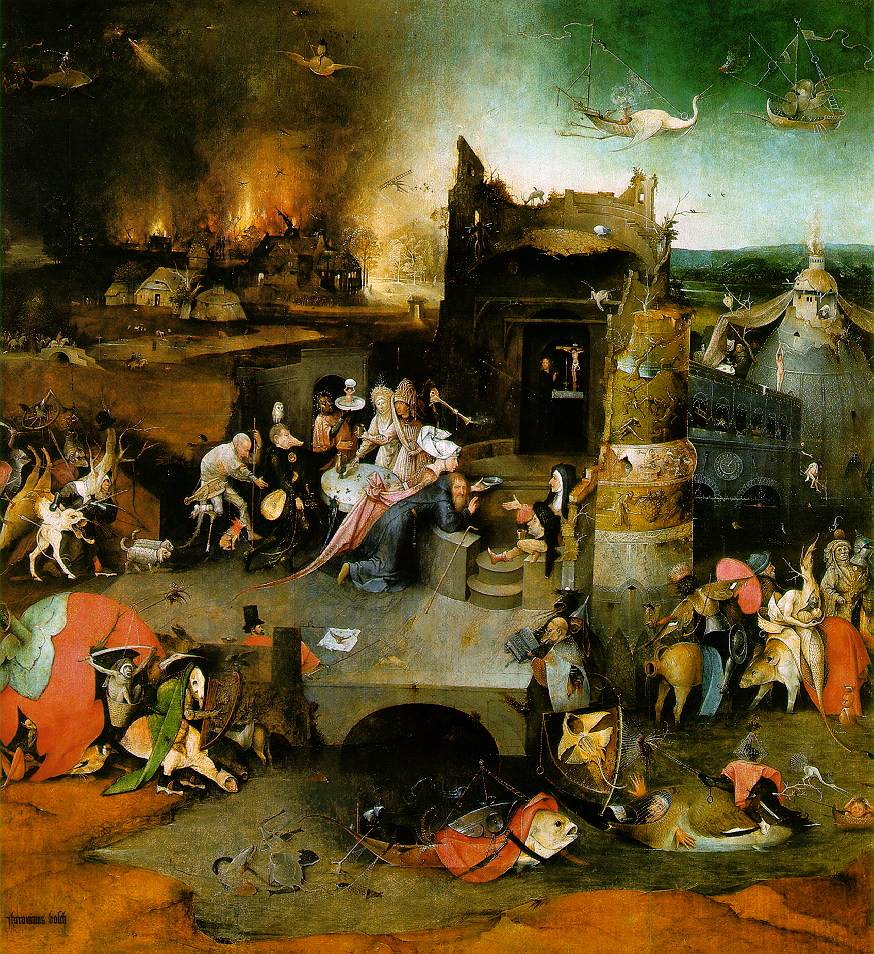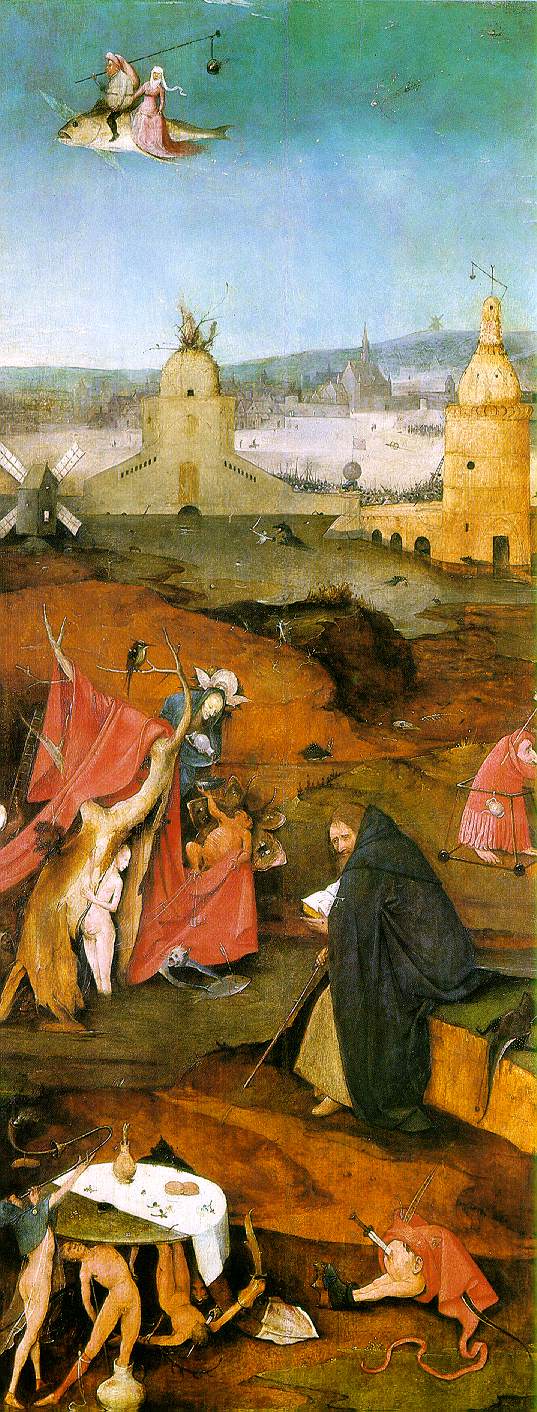


He was reproted to be a member of a religious group called "The Brotherhood of our Lady" or something, but there was nothing too weird about this group. You can go to Wikipedia and read about him, so there's no sense in repeating all of it here. Suffice it to say that Bosch's paintings were incredibly intense and surreal, and they simply have to be saying something important about the development of Western culture and civilization.
So what was going on in Europe from 1450 to 1516 when Bosch died? LOTS! And in my humble opinion, Bosch's paintings are a big clue (to me anyway) about why Europe emerged from it's 2 millenium of darkness, punctuated by the disastrous marriage of Plato and early Christianty, into the Renaissance, the birth of science, the enlightenment, and modern times. But what do I know, I'm just a physicist. So what was going on in Europe when Bosch was buy painting? For one, the Medici family ascended into the upper ranks of Florence aristocracy, and began a 300 year rule. They did it by being one of the earliest banker families, something pretty amazing in medieval Europe given the fact that usury was supposed to be a sin (which is probably one of the main reasons why the European's didn't kill all the Jews - who else would be able to create capital and loan it to rulers to finance wars? But that's another story...).
The Medici family was notorious. Immensely wealthy, they took over Florence, became Dukes and other noblemen, spawned 3 popes, and Catherine de Medici married Henri II and became queen of France from 1547 to 1559. As was true with all the Medici's, Catherine was a despot, and pretty much ruled France from 1559 to 1589 when Henri II died, dominating her sons Francis II, Charles IX, and Henri III. She is given all the credit for the "St. Bartholomew's Day Massacre" in 1572 where they killed as many Huguenots as they could. I guess you could give her credit for founding Canada, because after that the Hugeunots left France in droves.
But also true to form, she used her wealth to create incredible works of art. She was a collector, had her picture painted by anyone who could paint, but was really known for building the Tuileries and many other notable bridges and tombs in Paris. One of her sculptures contains the heart of her husband Henri II. If you ever go to Paris, walk around the Jardin Luxembourg and near the entrance to Rue de Medici you'll see an amazingly beautiful sculpture as an homage to her former home in Florence. On a nice warm day in Paris, go to the Luxembourg, and sit by the fountain in the shade and think about all of the butchering and art that defined the Renaissance. It's mind blowing.
Back to the Medici story. I got much of this from Wikipedia, but it's worth boiling down. The first Medici with real money was Averardo, but it was his son Giovani who became so rich that his family line ruled as nobelmen. His son Cosimo was the first Duke of Florence, and now we're in the mid 15th century. Cosimo's line ruled for 100 years, then passed power to another branch but that's another story. So we have Averardo->Giovani->Cosimo->Piero/Lorenzo. Piero and Lorenzo were brothers, and it was Lorenzo who was called "The Magnificent" who ruled until 1492 (interesting date eh?). Lorenzo's son Piero ruled after him, his other son Giovanni became Pope Loe X, and his daughter who married the son of Pope Innocent VIII, who was famous for things like the crusades and the Spanish Inquisition. Nasty nasty people these popes. What were these Medici popes famous for? Art! And spending vast sums on armies (Europe was constantly at war somewhere or another) and weddings and crusades. So why is this important for some random person's obsession with Bosch? Well, Pope Leo X was also Pope when Martin Luther basically stuck his tongue out at the Pope and said that he didn't need any priest or Pope to definie his or any other person's theology, and thus began the reformation and the Renaissance.
What else was going on during this time? Other than Columbus "discovering" the new world and living to report it? Can you imagine what a bombshell this would be? And then there was Copernicus, 1473-1543, a Catholic cleric and dilletante who dabbled in astronomy (which was a pretty primitive observational science, and remember this was way before Galileo (1564-1642) invented the telescope around 1600. Anyway Copernicus was pretty interesting, and probably you wouldn't like him if you met him. And he believed in Ptolemy's theory, but just decided to play around with the data and he found that the whole theory worked alot better if you put the sun at the center instead of the earth. Although he didn't necessarily believe it, it was the start of something that was picked up by Kepler (1571-1630) who also believed it at first but after studying Mars (the most eccentric orbit of all the planets) decided that the ellipse fit better. Then came Galileo, who got into all kinds of trouble with the Roman Catholic church, and by the time of Newton (1642-1727) the march to the Enlightenment was in full swing, the church had lost its grip (of course the Protestants took up some of the slack) and things were really changing. So I guess my thesis here is that Bosch's paintings reflected the heavy heavy times of ca 1500, where people were still mired in the superstition of religion and the questions of meaning and afterlife, yet all around them those institutions were clearly ossified and corrupt and immoral. Such a quandry among ignorant people must have been very hard to handle. If you don't believe me, check out some of these Bosch paintings!
This is a beautiful triptych, which means that there are 3 panels: 2 smaller outer ones and a larger central one. The are all three over 4 feet tall, and take your breath away when you first see them. As the first Bosch painting I ever saw, it kind of sticks on me. I think I stood in front of it for an entire hour just looking at all the detail.
There's more than one St. Anthony apparently! There's the modern on born in 1195 in Lisbon, St. Anthony of Padua, and it's that one that became the patron saint of lost things. But there's another St. Anthony, a much older one, who lived in the early Christian era, ca. 300 AD, and he's called St. Anthony the Great, born in Egypt and lived in Alexanderia for most of his life except for the 13 years that he was in the desert. He was born wealthy, converted to Christianity as an adult, and gave away his wealth according to the usual teachings of Christ about rejecting worldly treasures. It was during these 13 years in the desert, living entirely alone for long streteches, that he met his temptations and tribulations, which he overcame with the power of prayer. He fought the devil the whole time, who used such tactics of temptation as (yegads) sex and women (ah, the forbidden fruit strikes again). The devil beat him and tempted him and just made his life miserable (as if living in the 3rd century wasn't miserable enough), he supposedly spent a great number of years in solitary confinement only to emerge healthy and vibrant, and lived to be 105. Here is one of the more colorful tales:
Saint Anthony was born in Egypt of good and religious father and mother, and when he was but twenty years old, he heard on a time in the church read in the gospel, that said: If thou wilt be perfect go sell all that thou hast and give it to poor men; and then according thereto he sold all that he had, and gave it to the poor people and became an hermit. He had overmany temptations of the devil. Then on a time when he had overcome the spirit of fornication which tempted him therein by the virtue of his faith, the devil came to him in the form of a little child all black, and fell down at his feet and confessed that he was the devil of fornication, which Saint Anthony had desired and prayed to see him, for to know him that so tempted young people. Then said Saint Anthony: Sith I have perceived that thou art so foul a thing I shall never doubt thee. (Catholic Forum)
Such is the context for the following pictures. Click on the image to see a blowup. This picture is truly amazing and worth spending alot of time on. To quote from the WebMuseum, Paris writeup:
Bosch's spiritual heroes were the saints who endured both physical and mental torment,
yet remained steadfast. Among the saints, Bosch's favorite was Saint Anthony, the subject
of his triptych The Temptation of Saint Anthony (c.1500; Museo National de Arte Antiga,
Lisbon), which features physical punishment on the left wing, a Black Mass in the center,
and the blandishments of food and sex on the right wing. St. Anthony's triumph over such
trials is mirrored by those of other hermit saints and by the Passion of Christ, whose
arrest and carrying of the cross adorn the exterior of the Lisbon altarpiece.
Bosch was preoccupied with themes of torment and the sinfulness of man, which replaced
earlier, more optimistic visions of Christ and the Virgin with feelings of anxiety,
fear, and guilt. His sources for such unusual images were the dark corners of the
medieval imagination, the gargoyles and monsters of cathedral decoration, and the marginal
illustrations of books and popular prints.
In Bosch's day, temptation not only had the meaning it has today, but also meant
physical/mental assault by demons. So St Anthony is not only tempted by the pleasures
of the flesh and so on, he is also beaten up and terrorized by the demons.
So there you have it. Sex, physical torment, demons, St. Anthony had it all. And this painting pulls no punches!

| 
| 
|